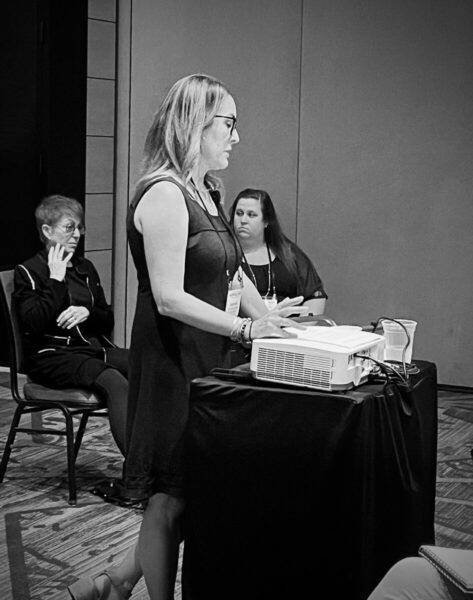by Heidi Fettig Parton
This post is part of a HippoCamp 2022 recap series, with guest blog posts written by HippoCamp attendees. Learn more about our conference for creative nonfiction writers.
In Jeannine Ouellette’s memoir, The Part that Burns, the child narrator tells readers, “If something bad happens and only you see it, it could be your fault.” This impressively crafted sentence does so much heavy lifting. After reading it, I thought differently about the potential of a child narrator, and yet …
I almost didn’t attend Jeannine Ouellette’s HippoCamp 2022 breakout session, “How to Write Captivating and Convincing Child Narrators (And Why Your Work Might Benefit from One!)” I hadn’t slept much the night before after realizing housekeeping had (accidentally?) placed a mattress pad between the two top flat sheets on my bed rather than a comforter—but it was too late at night to do anything about it*. By 10 a.m. Saturday morning, I was tired and cranky. What I really wanted was a cold press from Central Market and a spot of sun to warm me.

Jeannine Ouellette presenting about child narrators at HippoCamp 2022. Photo by Heidi Fettig Parton
So, I almost … like … didn’t attend Jeannine Ouellette’s, umm, like breakout thing. OMG! Is that bodybuilder the C. Thomas Howell?! You know … Ponyboy. Anyway, what was I saying? Oh, yeah. I will never write a child narrator evvvver. [She rolls her eyes]. Reeaally. [She gives her tall, tall bangs a finger tease]. I don’t actually … like … need this session. [She snaps her gum]. I need … caffeine**.
Despite contending with stroppy teenage me, who emerges when I’m tired, I did attend Jeannine Ouellette’s breakout session. You must, I told myself. It doesn’t matter if you never ever write a child narrator. You will attend because Jeannine Ouellette is a skillful teacher, the kind of teacher who knows how to open your scared, closed off writing heart. You’ll attend because 10 am is your caffeine curfew—and you need sleep tonight.
Since reading Ouellette’s memoir, The Part That Burns last year, I’ve joined the ranks of her many ardent Ouellette workshop junkies and she knows me. As soon as I walked into the room, I told her, “I’m here, but I’m never going to write a child narrator.”
“Glad you’re here, Heidi,” she said, “You’ll learn, it all comes back to restraint.” I’d heard Ouellette talk about restraint before. I was intrigued, but not convinced. Not yet.
Throughout the workshop, Ouellette highlighted possibilities and pitfalls of employing a child narrator, which she defined as a narrator between ages 0 and 18. One gift of the child narrator is that “transformation” is built into their characters. Another is the unique voice they lend to the narrative. Child narrators often introduce a playful element to the page, even (or especially) when writing about the difficult stuff. Indeed, child narrators can offer distance between the narrator and the traumatic events, as Ouellette’s did in The Part That Burns.
As we neared the middle point of the presentation, Ouellette moved on to discussing how child narrators could be used to point out social short comings or tell unsavory truths without the need for censor or societal filter. By then, I was drinking Ouellette’s Kool-Aid and not thinking (that much) about cold press, even when she warned that the use of child narrators can be risky because they’re often viewed as “a little precious.”
An accomplished writer advised Ouellette against a child narrator when she was writing The Part That Burns. In the end, Ouellette disregarded that advice and trusted her intuition. She had a hunch a child narrator might be the very thing to break her story open. She was right.
Ouellette set attendees to writing (some of us without caffeine), using an “I remember” prompt. She suggested staying within the age and situational realm of our child narrator. By using this kind of restraint, we allow our readers to perceive, reflect, and emote for themselves. “What if I can’t remember my childhood,” one of the attendees asked. Ouellette assured her it often takes remembering just one small detail—in The Part That Burns, it was the objects her mother kept on her dresser—for more details and memories to follow.
In that partitioned off hotel ballroom, my 14-year-old narrator emerged on paper as I began with this one remembered detail: the delightfully cool heaviness of the pink linen shirt my brother sent me from California. Ouellette’s prompt worked its magic and pried open my closed off writing self to story and memory. By employing the restraint of a child narrator, I wrote without restraint. This, by the way, was worth a bumpy plane ride, a night sleeping under a mattress pad, and a morning without cold press.
*I did not stay at the official conference hotel. I was a late registrant and, unfortunately, there was no room in that inn.
**This paragraph does not reflect Ouellette’s teachings on writing the child narrator. Ouellette emphasizes that writing a child narrator does not mean sounding like a child narrator; instead, the narrator—through authenticity and consistency—only need bring readers to a place that’s deeply true.
>>See more HippoCamp 22 recap posts, content, and more here.
Heidi Fettig Parton (she/her) holds an MFA in creative nonfiction from Bay Path University. Her essays have appeared in or are forthcoming from Brevity, Forge Literary, Multiplicity, The Manifest-Station, North Dakota Quarterly, Sweet Lit, and more. Connect with her on Instagram @heidifettigparton or Twitter @FettigParton.

